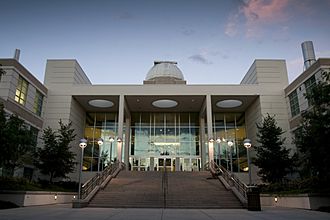Eyring Science Center facts for kids
Quick facts for kids Carl F. Eyring Science Center |
|
|---|---|

Eyring Science Center, August 2005
|
|
| General information | |
| Type | Educational |
| Location | Provo, Utah United States |
| Coordinates | 40°14′49″N 111°39′00.9″W / 40.24694°N 111.650250°W |
| Named for | Carl F. Eyring |
| Completed | 1950 |
| Design and construction | |
| Architect | Fred L. Markham |
The Carl F. Eyring Science Center (ESC) is an important science building located on the Brigham Young University (BYU) campus in Provo, Utah, United States. It was finished in 1950 and was named in 1954 after Carl F. Eyring, a well-known scientist. The ESC is a place where students and professors learn about and explore many different areas of science.
Contents
What You'll Find Inside
The ESC is home to several science departments. These include the Physics and Astronomy Department, the Geology Department, and the Food Science and Nutrition Department. The Chemistry Department used to be located here, but it has since moved to another building.
Cool Labs and Research
In 1968, an underground physics research lab was added to the north side of the building. Scientists here have studied things like lasers, acoustics (the science of sound), and tiny materials called nanotechnology. The building also has special acoustics labs. These include two anechoic chambers, which are rooms designed to completely absorb sound, and two reverberation chambers, which are rooms designed to make sound echo a lot. These rooms are used for sound research.
The Planetarium and Observatory
The Royden G. Derrick Planetarium is also inside the ESC. This planetarium has 119 seats and a large dome that is about 39 feet (12 meters) wide. It was built in 2005 to replace an older, smaller planetarium. In the summer of 2006, a new dome was put on the ESC's observatory. This helps students and scientists study stars and planets better right on campus. The 5th and 6th floors of the ESC are part of the Orson Pratt Observatory, where people can look at the night sky.
Fun Facts and Features
In the early years of the ESC, the lobby often displayed dinosaur bones and models collected by James A. Jensen. While dinosaur displays are less common now, the building's main lobby is famous for its Foucault pendulum. This pendulum swings back and forth, showing how the Earth rotates. The lobby also has a student-run restaurant called the Pendulum Court, which is open during the fall and winter school semesters. The ESC was also the very first building at BYU to have an elevator!
See Also
- List of Brigham Young University buildings
- List of science centers

